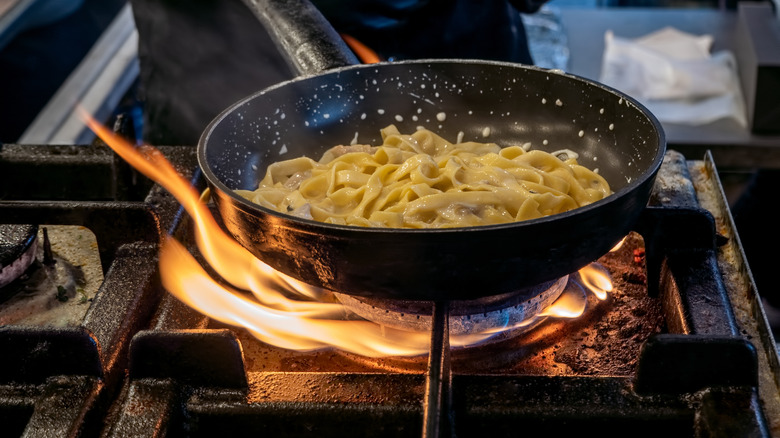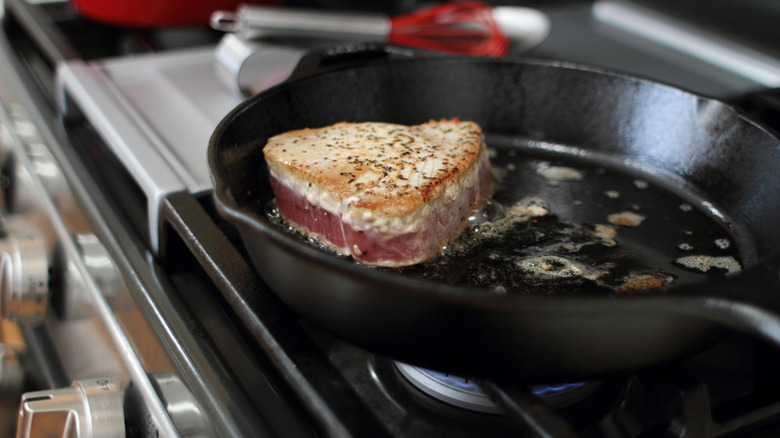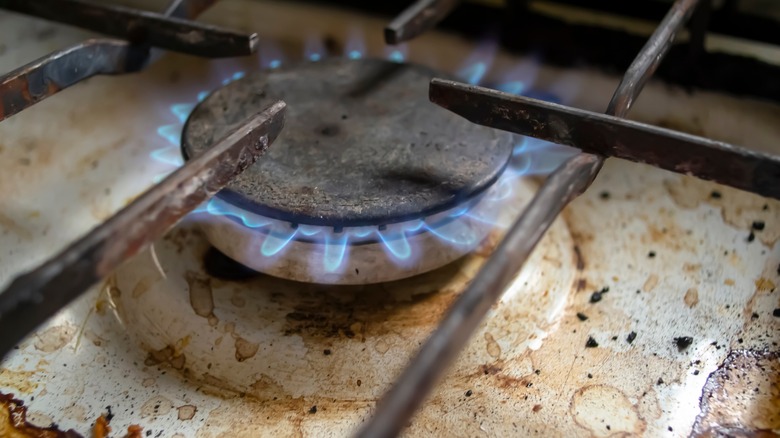The Gas Stove Mistake That Permanently Damages Pans
There's something comforting about defaulting to your favorite burner on the gas stove. It's your go-to spot, regardless of the size of your pan. But did you know that burners are sized differently for a reason? Gas stoves use exposed flames to provide instant heat and can increase the temperature of your cooking surface rapidly, discoloring your pan or leaving burn marks if the temperature is too high or concentrated. Ensuring the bottom of your pan and the burner have similar diameters decreases this risk.
It's especially important to choose the right size burner and monitor temperatures if your cookware is better suited to low- to medium-heat cooking (like most non-stick or lightweight pans). Pairing such pans with a burner that is too large can quickly expose them to temperatures they weren't built to withstand. Over time, extreme heat can warp lightweight pans (meaning they can change shape or twist), or even degrade the non-stick coating. You'll know you've chosen a burner that's too big if flames are visible around the pan, or extend up its sides.
Picking a small burner for a very large pan is also a no-no, as heat won't distribute as evenly across a surface area that is large relative to the size of the burner. This can result in a concentrated circle of heat, or a hot spot, in the pan's center. Hot spots weaken the center of your pan and can also cause them to warp.
Choosing the correct pan for gas stove cooking
If you carefully monitor heat and cooking duration, you can use most types of cookware on a gas stove. However, for the best results, select cookware that can distribute heat evenly (as gas stove flames are not always uniform), handle instant heat, and withstand high temperatures.
A stainless steel pan is a good option for gas stove cooking because it is made of highly durable material, retains heat well, and distributes heat evenly and quickly across the bottom of the pan. As long as the size of the stainless steel pan matches that of the burner, you can safely use this type of pan for cooking at high temperatures.
Since stainless steel is lighter than cast iron, it is also a good choice if you want to easily move the pan or toss or flip its contents. If you don't need an easily mobile pan and want to use a cooking technique that requires very high temperatures (like searing or frying), then opting for a cast iron pan is a great choice. Cast iron can withstand temperatures of up to 650 degrees Fahrenheit, and is excellent at retaining heat for long periods.
How to use a gas stove safely
Gas stoves have plenty of perks: They can work without electricity, offer rapid and precise temperature control, and even provide a convenient means to safely smoke food on an open flame from the comfort of your kitchen. However, when used incorrectly, gas stoves can be a fire hazard.
Keeping your gas stove clean of grease and debris is essential to limiting the risk of a fire. Take your gas stovetop apart for proper cleaning, and pay special attention to the areas around the burners where grease may have accumulated during cooking. Additionally, a vital tip for safe gas stove use is to be aware of the signs of a gas leak. Common signs of a leak include the sulfur-like scent of gas, or a change in the color of your burners' flames from blue to yellow or orange.
Finally, remember to always turn your burners off after use, even if the flame goes out by itself, or the igniter doesn't work as expected. Each burner on your gas stove is equipped with an ignitor that reacts with the gas to produce a flame. If you try to turn a burner on and notice a delay in the time it takes for flames to appear, or a complete lack of flames, this could be a sign that your ignitor is blocked. Be sure to switch off the burner before cleaning the ignitor, as gas will continue to flow if you leave it open.



